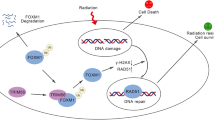Abstract
Poly(ADP-ribose) polymerase 3 (PARP3), a critical player in cellular response to DNA double-strand breaks (DSBs), plays an essential role in the maintenance of genome integrity. However, the role of PARP3 in tumorigenesis especially in glioblastoma remains largely unknown. In the present study, we found that the mRNA and protein levels of PARP3 were upregulated in primary glioblastoma tissues. Knockdown of PARP3 expression by lentivirus-based shRNA decreased cell glioblastoma proliferation and inhibited tumor growth in vivo by using a xenograft mouse model. Furthermore, we found that silencing the expression of PARP3 resulted in a synergistic radiosensitizing effect when combined with radiotherapy in glioblastoma cell lines. At the molecular level, we found that PARP3 interacted with FoxM1 to enhance its transcriptional activity and conferred glioblastoma cell radioresistance. Thus, our data suggest that PARP3 could be a therapeutic target to overcome radioresistance in glioblastoma.






Similar content being viewed by others
References
Wen PY, Kesari S. Malignant gliomas in adults. N Engl J Med. 2008;359(5):492–507.
Van Meir EG et al. Exciting new advances in neuro-oncology: the avenue to a cure for malignant glioma. CA Cancer J Clin. 2010;60(3):166–93.
Kruh GD. Introduction to resistance to anticancer agents. Oncogene. 2003;22(47):7262–4.
Perona R, Sanchez-Perez I. Control of oncogenesis and cancer therapy resistance. Br J Cancer. 2004;90(3):573–7.
Erpolat OP et al. Outcome of newly diagnosed glioblastoma patients treated by radiotherapy plus concomitant and adjuvant temozolomide: a long-term analysis. Tumori. 2009;95(2):191–7.
Noda SE et al. Molecular advances of brain tumors in radiation oncology. Semin Radiat Oncol. 2009;19(3):171–8.
Augustin A et al. PARP-3 localizes preferentially to the daughter centriole and interferes with the G1/S cell cycle progression. J Cell Sci. 2003;116(Pt 8):1551–62.
Rouleau M et al. PARP-3 associates with polycomb group bodies and with components of the DNA damage repair machinery. J Cell Biochem. 2007;100(2):385–401.
Rulten SL et al. PARP-3 and APLF function together to accelerate nonhomologous end-joining. Mol Cell. 2011;41(1):33–45.
Fenton AL et al. The PARP3- and ATM-dependent phosphorylation of APLF facilitates DNA double-strand break repair. Nucleic Acids Res. 2013;41(7):4080–92.
Beck C et al. PARP3 affects the relative contribution of homologous recombination and nonhomologous end-joining pathways. Nucleic Acids Res. 2014;42(9):5616–32.
Langelier MF, Riccio AA, Pascal JM. PARP-2 and PARP-3 are selectively activated by 5′ phosphorylated DNA breaks through an allosteric regulatory mechanism shared with PARP-1. Nucleic Acids Res. 2014;42(12):7762–75.
Wang Z, et al. Glioblastoma multiforme formation and EMT: role of FoxM1 transcription factor. Curr Pharm Des. 2014;21(10):1268–71.
Zhang N et al. FoxM1 inhibition sensitizes resistant glioblastoma cells to temozolomide by downregulating the expression of DNA-repair gene Rad51. Clin Cancer Res. 2012;18(21):5961–71.
Zhang Y et al. FoxM1B transcriptionally regulates vascular endothelial growth factor expression and promotes the angiogenesis and growth of glioma cells. Cancer Res. 2008;68(21):8733–42.
Dai B et al. Aberrant FoxM1B expression increases matrix metalloproteinase-2 transcription and enhances the invasion of glioma cells. Oncogene. 2007;26(42):6212–9.
Liu M et al. FoxM1B is overexpressed in human glioblastomas and critically regulates the tumorigenicity of glioma cells. Cancer Res. 2006;66(7):3593–602.
Jackson SP, Bartek J. The DNA-damage response in human biology and disease. Nature. 2009;461(7267):1071–8.
Chapman JR, Taylor MR, Boulton SJ. Playing the end game: DNA double-strand break repair pathway choice. Mol Cell. 2012;47(4):497–510.
Symington LS, Gautier J. Double-strand break end resection and repair pathway choice. Annu Rev Genet. 2011;45:247–71.
Lieber MR, Wilson TE. SnapShot: nonhomologous DNA end joining (NHEJ). Cell. 2010;142(3):496. e1.
Mohindra P et al. Non-cytotoxic radiosensitizers in brain radiotherapy: journey till the first decade of this millennium. Curr Cancer Drug Targets. 2012;12(3):260–78.
Haar CP et al. Drug resistance in glioblastoma: a mini review. Neurochem Res. 2012;37(6):1192–200.
Kesari S et al. DNA damage response and repair: insights into strategies for radiation sensitization of gliomas. Future Oncol. 2011;7(11):1335–46.
Chinot OL et al. Bevacizumab plus radiotherapy-temozolomide for newly diagnosed glioblastoma. N Engl J Med. 2014;370(8):709–22.
Conflicts of interest
None
Author information
Authors and Affiliations
Corresponding author
Rights and permissions
About this article
Cite this article
Quan, JJ., Song, JN. & Qu, JQ. PARP3 interacts with FoxM1 to confer glioblastoma cell radioresistance. Tumor Biol. 36, 8617–8624 (2015). https://doi.org/10.1007/s13277-015-3554-4
Received:
Accepted:
Published:
Issue Date:
DOI: https://doi.org/10.1007/s13277-015-3554-4




